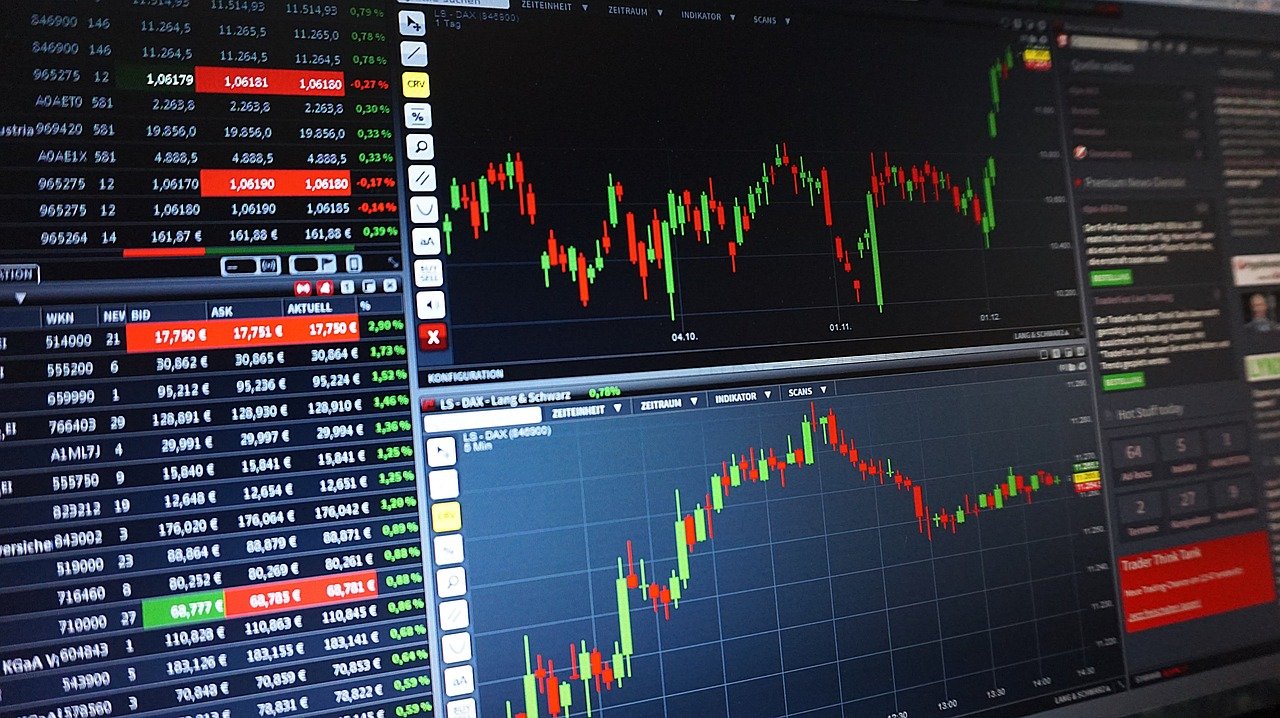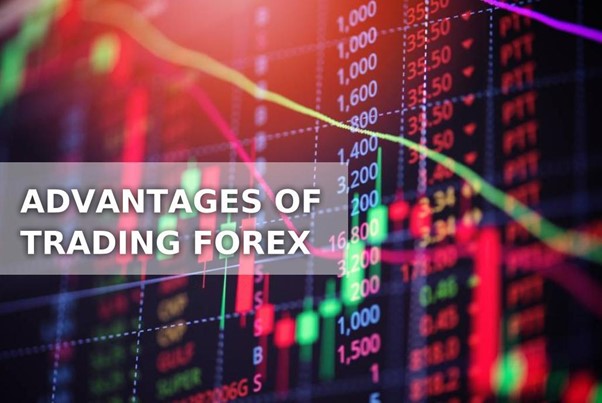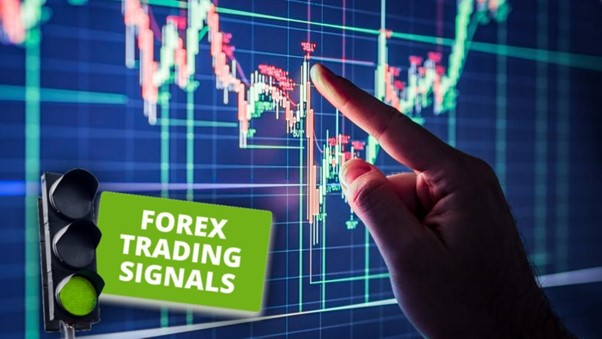Forex data is represented on the x-y plane of price against time i.e. on a graph the horizontal axis represents time, and the vertical axis represents price levels. A forex chart shows you price values and at what time was the price at that value. At Forex Signals Lab, we do this type of research for you in our forex signal service channels: Elite and VIP Premium. We the provide you with great entry and exit positions with the additional information of Take Profit (TP) and Stop Loss (SL). We’ll cover basics below with the type of charts, pairs, risk management, and more.
Types of Forex Charts
Line chart
This type of chart is not commonly used in forex trading since it doesn’t support most of the technical analysis tools that we are going to learn in the next section.
Bar charts
Is the second most common chart. In figure 1, the ‘low’ represents the lowest price that was attained at that particular time period. The ‘high’ represents the ‘highest’ price that was attained at that particular time period. The ‘open’ represents the opening price for that particular time period. The ‘close’ represents the closing price for that particular time period.
If you are using a four-hour timeframe then low will be the lowest price in a period of four hours. The high will be the highest price attained in a period of four hours. Open, is the opening price for those four hours and close is the closing price of that four-hour period.
Figure 1: A bar of a bar chart
Figure 2 Candlestick bars
Candlestick charts
These are the most common charts in forex trading. They are widely used for technical analysis. There are two types of candlesticks. The ones that represent an upward movement of the market or bullish candles and the ones that represent the downward movement of the market or bearish. Bullish candles are usually in green color. Bearish, on the other hand, is red. Sometimes the colors are black and white, so the important thing to remember is that bullish candles are hollow i.e. have the same color as the background.
In figure 2, the ‘low’ represents the lowest price that was attained at that particular time period. The ‘high’ represents the ‘highest’ price that was attained at that particular time period. The ‘open’ represents the opening price for that particular time period. The ‘close’ represents the closing price for that particular time period. Lower and upper shadow represents the distance between opening and closing price with the lowest or highest price.
For instance, if you are using a 1-hour timeframe then low will be the lowest price in the period of one hour. The high will be the highest price attained in the period of one hour. Open, is the opening price for that one hour period and close is the closing price of that one hour period.
How to Trade Forex
Forex trading is simply investing in economies of respective currencies. If you think that, the British economy will rise in the following week, then you will buy the Great Britain Pound (GBP) and after the currency gain as much value as you anticipated you sell your pounds and take your profit.
Let’s do a real money example where you have $100 and then you buy Great Britain Pound at the exchange rate of 1 GBP ® 1.2500 USD, that will get you 80 British pounds. After three days the value of pound rises so that the exchange rate becomes 1 GBP ®1.3500 USD then you sell your pounds at that rate and you get 108 USD with a profit of $8. The exchange rate, therefore, is the ratio of a currency valued against another currency. From our example, the exchange rate of 1 GBP ® 1.2500 USD means you need 1.25 USD to get 1 GBP.
The following table will help you if you are a complete beginner to understand these currencies and their short forms. There are many currencies in the market, but these are the most common ones.
CURRENCY NAME | CURRENCY SHORT FORM |
GREAT BRITAIN POUND | GBP |
UNITED STATES DOLLAR | USD |
EURO | EUR |
JAPANESE YEN | JPY |
CANADIAN DOLLAR | CAD |
SWISS FRANC | CHF |
AUSTRALIAN DOLLAR | AUD |
Table 1: Major currency names and their short forms
Currencies are traded in pairs, for instance in our earlier example the pair is GBPUSD. The first currency in the pair is called base currency and the second currency is called quote currency. When trading you are trading the base currency against the quote currency. You will buy when you believe that the base currency is going to appreciate and you will sell when you believe that the base currency is going to depreciate. The act of buying is also called long, for instance in our example we went long GBPUSD. Selling is also called short.
So let us look at a short example; let’s take a pair of USDJPY at a rate of 107.93 and as I have explained before, rate of 107.93 means we need JPY 107.93 to get 1 USD. So if we sell 100 USD at this rate we will get 10793 JPY. So let’s say the value of USD depreciates to 100.17, we buy USD at that rate and we will get $107.75 our profit is now $7.75.
There are two types of traders; bulls and bears. Bulls are traders that take advantage of an appreciating market or upward market. Bears are traders that takes advantage of a depreciating market or downtrend market. An upward market is sometimes called bullish and downtrend market bearish.
Types of Currency Pairs
Major currency pairs
Major currencies pairing with USD you get major currency pairs. Major currencies are CAD, USD, CHF, GBP, EUR, JPY, AUD, and NZD. Major currency pairs are the most liquid and most people prefer these because of that.
Minor/Crosses currency pairs
These are major currencies pairing with each other to make crosses. No USD is involved in these pairs are usually the minor pairs. They have less liquidity but they are free of US economic news. People also trade these, when they want to avoid USD microeconomic deviations.
Exotic currency pairs
Exotic pairs contain exotic currencies. Exotic currencies are currencies from emerging economies or developing countries. Most traded exotic currencies are Mexican peso (MXN), South African Rand (ZAR) and Argentina Peso. These exotic currencies are paired with USD mostly. They lack liquidity so it is expensive to trade them as the bid-ask spread is usually large to compensate for the lack of liquidity.
What is Lot Size?
A lot is a number of base currency unit you will buy or sell. Lot size measures the volume of transactions in the forex market.
Standard lot | 1 lot = 100 000 units of base currency |
Mini lot | 0.1 lot = 10 000 units of base currency |
Micro lot | 0.01 lot = 1 000 units of base currency |
Table 2 lot distribution
If we want to buy GBPUSD at a rate of 1.2500 with a volume of 1 lot. Since 1 lot = 100 000 units of the base currency, so in our example it is £100 000. Therefore to conduct this transaction, we are going to need $125 000.
If we want to buy GBPUSD at a rate of 1.2500 with a volume of 0.1 lot. Since 0.1 lot = 10 000 units of the base currency, so in our example it is £10 000. Therefore to conduct this transaction, we are going to need $12 500.
And if we want to buy GBPUSD at a rate of 1.2500 with a volume of 0.01 lot. Since 0.01 lot = 1000 units of the base currency, so in our example, it is £1000. Therefore to conduct this transaction, we are going to need $1250.
Such amounts can either be too much to afford for some traders or can be too big of an investment to some traders and they are not ready yet. So what do we do? We use margin trading.
Margin Trading
In margin trading, traders can trade larger volumes with small investments using borrowed money from their brokers. You will get to keep all the profits obtained in the trade and there are no commissions charged for the borrowed money. Margin trading is good for you since it enables you to trade large volumes and therefore bring you large profits, but it also increases your losses if the market goes against you. Later in this guide, we will discuss risk management and how you can use margin trading without subjecting your account to high risks. Now how does margin trading work? In margin trading, you have leverage, margin, and equity.
Leverage
Leverage indicates how much money your broker can lend you in your transactions. If your leverage is 1:100 that means your broker will lend you 99% of your transaction and you will need to have 1% of the transaction.
Let’s say we have $250 in or account and we want to conduct a transaction in our example of buying GBPUSD at a rate of 1.2500 with a volume of 0.1 lot, we will need $12 500 and our balance is $250. For leverage of 1:100, we will only need $125 and our broker will lend us $12 375. And in this case, we can now conduct our transaction in the forex market.
But this looks too good to be true right? A broker lending us money and we get to keep all the profits without commissions! What if I get a loss instead? And why he is willing to borrow us money? Margin and equity is the answer.
Margin
Margin is the percentage that a trader is required to put in the transaction. From our above example, our margin is $125. If we take away our margin from our balance, i.e. $250 – $125 = $125. The remaining $125 is called a free margin.
Equity
Equity is account balance while the trade is still open. Any unrealized profit or loss can be reflected in your equity. It reflects if the market is going in your favor or it’s going against you. So equity is free margin + margin. Now let us look at two instances, one of unrealized profit and another of unrealized loss; and it is called unrealized profit/loss because the trade isn’t closed yet.
Unrealized loss. From our example, we have $125 as our margin and $125 as our free margin. If the market moves against us and generates -$100, then our free margin decreased to $25. Thus, our equity will be $150; meaning if we decide to close this trade at this level, we will remain with $150.
Your margin is the one that protects that borrowed money from your broker. Brokers set limits as to what is the minimum margin value, if the market moves against you to that value you will get a margin call and if you don’t close your position then your broker will close it for you to protect the funds that they borrowed you. We will discuss stop-loss order, a way to help you prevent your losses while they are still small.
Unrealized profit. From our example, we have $125 as our margin and $125 as our free margin. If the market moves in our favor and generate +$100, then our free margin increased to $225. Thus, our equity will be $350; meaning if we decide to close this trade at this level, we will have $350.
What is Pip?
A pip is a measure of the difference between two prices in a market. The movement of prices in the market is measured in pips. For instance, the value of USDJPY moved from 108.31 to 108.97. Here, we take the difference of which is 108.97 – 108.31 = 6.6 pips. So the USDJPY market moved 6.6 pips. But how is it 6.6 and not 66 or 0.66?
One pip is equal to 0.0001 unit of quote currency. For pairs quoted in JPY i.e. XXXJPY, One pip is equal to 0.01 unit of the quote currency. For example, GBPUSD is quoted at 1.2249 and after an hour, it is quoted at 1.2239; so the price moved down 10pips.
These days, most brokers offer price in 5-digit and 3-digit for JYP quoted currencies. But the value of one pip is still equal to 0.0001 and 0.01 unit of quote currency respectively. In the same example but 5-digit quoted, GBPUSD is quoted at 1.22491 and after an hour, it is quoted at 1.22393; so the price moved down 9.8 pips.
Ask and Bid Price and Spread.
Ask price
This is the price available for buyer traders to buy. If you want to buy a currency in the market, the price available for you is called ask price.
Bid price
This is the price available for seller traders to sell. If you want to sell a currency in the market, the price available for you is called bid price.
Spread
Spread is the cost of conducting a transaction in the forex market. It is calculated by taking ask price minus bid price. Disadvantages of big spreads.
What is a Pip Value?
A pip measures movement of prices in the market. And in forex, we get profit/loss from price movements. To measure the value of money that each pip carries is a work of pip value. The formula for calculating pip value is; and is measured in units of the quoted currency.
For example, the price of EURGBP moved 10 pips in our favor and we had opened a position with a lot size of 0.1. To determine the value of one pip in this transaction we use our pip value formula and we will get £ 1. So this means for every pip, there is one pound, so for 10 pips that moved in our favor, we get 10 pounds. Now you will have to convert this value to your account currency, for instance, if your account is in USD, then you will take the asking price of GBPUSD at the time of your position closing and then you use that to convert your pounds to USD.
Not all the time you will need to do the math because your trading software will do those for you, the only time you will need to do the math yourself is when you will be determining your risk management procedures, which we will discuss in a moment.
What is a Position in the Forex Market?
A position in the forex market is the commitment you make in the market by buying or selling a currency pair. Opening a long position means, you have bought currency in the market and opening a short position is the same as saying you have sold currency in the market.
What is stop-loss?
Stop-loss is an order that you set in for your position to protect your account from big losses in case the market moves against you. Forex trading involves high risks of capital and therefore, a stop loss comes in handy to help prevent large losses.
What is take profit?
Take profit means what it says. It’s an order you place for your position to take profit when the market reaches profits levels that you anticipated. This is an important tool if you don’t want to stay in front of your computer monitor waiting for your profit levels.
Risk management
Trading forex is riding a motorbike, they both involve high risks. For motorbike riders, they risk their lives by riding at a high speed and/or riding without a helmet. In forex, your helmet is stop loss and your speed is lot size. You have to risk as small amount as possible and always trade with a stop loss.
There is a formula for calculating lot size, depending on the amount of money you are willing to risk.
The risk in the formula is the amount of money you are willing to risk. For instance, you have $250 in your account, and you are willing to risk only 10% of it, then risk will be $25. Now from your analysis, if your stop-loss is 50 pips away, then from the formula your lot size will be 0.05.
An important factor to remember is converting your risk amount to your quote currency value. For instance, in the above example, let say you wanted to trade EURGBP, then your risk of $25 will be converted to GBP which is the quote currency before plugging it to the formula.
All successful traders use risk management in their trading, so do not let the market teach you the hard way; start risk management the moment you open a demo account.
Types of orders
Instant execution
Is a buy or sell position that is being executed instantly.
Buy limit
Buy position that will be executed when the price reaches a certain level above the market price.
Sell limit
Sell position that will be executed when price react a certain level above the market price.
Buy stop
Buy position that will be executed when the price reaches a certain level below the market price.
Sell stop
Sell position that will be executed when price react a certain level above the market price.
Conclusion
The best way to learn how to trade forex is to setup your account and start trading with a demo account.
This will prepare you to start trading with your own money on MetaTrader4. Once you get going, it’s just rinse and repeat.
Get out there and get started trading forex!













